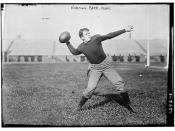It is my opinion that a director makes meaning in a film, although the audience will apply their own reading of it. Film has its own "language" and there are a wide range of techniques a director can use to enable the audience to understand his meaning. The director uses mise-en-scène to contribute hugely to how meaning is made in a film - a large part of how the story is told comes from visual content. The elements covered by mise-en-scène are setting, props, costume, performance, lighting and colour. However, the director can be limited by genre conventions established over time, i.e. Westerns or sci-fi.
The setting of a film will immediately give the audience meaning and expectations for the film. For instance, the opening sequence of Thelma and Louise (1992) lets the audience know this film takes place in dry, barren wasteland of America. Props are inanimate objects used to enhance the audience's belief in the setting.
Sometimes props can overlap into becoming part of a costume, for instance a cowboy's gun. Costumes immediately tell the audience about the character - period, social class, lifestyle etc. Costumes and props can both help to define a films' genre. An actor's performance in a film is greatly aided by costumes and props, but the audience generally has differing opinions about characters. Using Thelma and Louise as a reference point again, although some people may think the two lead characters are heroines, others may disagree and think that they should have been caught and punished for their crimes. Another thing a director can have no control over is the audience's perception of an actor that comes from outside the film. Tom Hanks, Jim Carrey and Steve Martin are three examples of actors which the audience will have very definite opinions of before...



Very good
this essay has some good points, nut you dont point out the most obvious example of the audience creating meaning- in citizen kane, the director hints at a few possibilitys, but ultimatly it is left to the viewer to decide on who or what "rosebud" is.
6 out of 6 people found this comment useful.